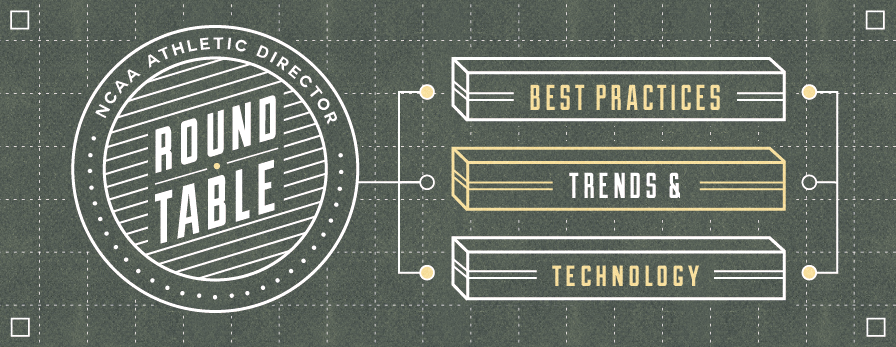In this Athletic Director Round Table, four athletic directors give their thoughts about best practices, trends, and technology in college athletics. We are grateful to Brad Bates, Barbara Burke, Eric Sexton, and Ron Wellman for sharing their perspectives in this round table.
How is technology changing the business of athletics?
 Brad Bates – Boston College
Brad Bates – Boston College 
Director of Athletics
First, technology can be a very effective pedagogical aid in developing students—particularly as each generation is more technologically savvy. Second, technology provides multiple avenues for students, fans, and alumni to follow our programs, provide feedback, interact with key stakeholders, and share information in meaningful ways. Next, there are new revenue streams that can increase the value of various departmental and program assets. Finally, technology is an exceptional analytical tool for daily operations and procedures.
 Barbara Burke – Eastern Illinois
Barbara Burke – Eastern Illinois 
Director of Athletics
Technology has been both positive and negative. Instant communication in some cases is great. However, nothing is private. We need to be out front of the ever-changing world of technology, accept that it changes daily and that it is now a part of our business. Having dedicated staff that focus on information technology is critical to maintaining appropriate hardware and software to complement the work of staff and coaches; this is important and appropriate.
 Eric Sexton – Wichita State
Eric Sexton – Wichita State 
Director of Athletics
The ability to communicate to our various constituencies (recruits, fans, donors, etc.) through social media and other instant forms of communication allows us to reach individuals on a regular basis without a significant expense. However, this does affect our ability to stay connected with a large segment of our aging demographic which still relies on other more traditional means of communication. In addition, the ability to utilize sophisticated databases to do research on best practices and other financial benchmarks allows for the ability to operate much more like a business. Winthrop Intelligence is just one example of how technology improves the way we can do the business of athletics.
 Ron Wellman – Wake Forest
Ron Wellman – Wake Forest 
Director of Athletics
Technological advancements are evident in all aspects of college athletics. The challenge is to use it to our advantage and not get bogged down in minutiae, which can easily happen. Whether it be in development, recruiting, coaching, ticket sales and distribution, financial analysis, or other administrative areas, technology will continue to play an important role in all that we do.
What is the biggest challenge facing administrators today?
 Brad Bates – Boston College
Brad Bates – Boston College 
Director of Athletics
Staying true to our primary purpose of maximizing the development of students.
 Barbara Burke – Eastern Illinois
Barbara Burke – Eastern Illinois 
Director of Athletics
For me personally in my situation it is having and maintaining the necessary resources to provide quality and competitive opportunities for student-athletes, coaches, and staff.
 Eric Sexton – Wichita State
Eric Sexton – Wichita State 
Director of Athletics
To continue to create environments in our departments where we continue to focus on conducting our business in an ethical and responsible way with the highest level of integrity (fiscal, moral, etc.).
 Ron Wellman – Wake Forest
Ron Wellman – Wake Forest 
Director of Athletics
There are numerous challenges in leading a complex department. Balancing the responsibilities and meeting the needs of all the constituencies that are important to a successful program top the list.
What characteristic is critical for successful administrators to have?
 Brad Bates – Boston College
Brad Bates – Boston College 
Director of Athletics
Communication skills. In many ways, the ability to sell is vital to success: Be it recruiting, fund-raising, teaching, marketing, coaching, or hiring.
 Barbara Burke – Eastern Illinois
Barbara Burke – Eastern Illinois 
Director of Athletics
I feel it is important for an athletic director to have CEO-like qualities. You may “know” the business but if you cannot properly communicate that knowledge the job will be much more difficult. Some of these qualities include but are not limited to: leadership, communication skills, ability to work with varied constituencies, being collaborative with the campus community, and understanding the role that intercollegiate athletics plays on your campus, not to mention the standards for financial management and fund-raising.
 Eric Sexton – Wichita State
Eric Sexton – Wichita State 
Director of Athletics
A high tolerance for ambiguity!
 Ron Wellman – Wake Forest
Ron Wellman – Wake Forest 
Director of Athletics
Leading in a manner that produces an environment that encourages everyone to go beyond their potential.
Name one recent innovative initiative you have implemented.
 Brad Bates – Boston College
Brad Bates – Boston College 
Director of Athletics
[We offer] professional development for our head coaches and senior staff utilizing an outside facilitator and sync the process with our strategic planning.
 Barbara Burke – Eastern Illinois
Barbara Burke – Eastern Illinois 
Director of Athletics
At the beginning of each fall semester on the Friday before opening classes the Department of Intercollegiate Athletics sponsors a T-shirt giveaway to all incoming new students. This initiative is part of the opening weekend orientation so the entire new student population participates. We create a yearly theme and brand the T-shirt to encourage the students to “Wear Blue”. The students arrive at the football stadium where our current student-athletes and coaches distribute the T-shirts. Once the students receive the shirt then they sit in the stadium and form the letters EIU, a class photo is taken and displayed on campus adjacent to the president’s office. The marching band and cheerleaders perform, the president and athletic director give a welcome, students are introduced to athletics, given information on admittance to events, and encouraged to join the student pep club.
 Eric Sexton – Wichita State
Eric Sexton – Wichita State 
Director of Athletics
We have implemented a software solution at our institution which will allow us to use technology to track our coaches’ recruiting calls and other text contacts to assist in better monitoring.
 Ron Wellman – Wake Forest
Ron Wellman – Wake Forest 
Director of Athletics
We are working on a solution that will allow us to secure and share data that will be extremely beneficial to every unit in our department.
What is the next big trend you see in NCAA Athletics?
 Barbara Burke – Eastern Illinois
Barbara Burke – Eastern Illinois 
Director of Athletics
I believe the current trend of providing additional resources to student-athletes will continue to be the topic of discussion. The new initiatives of stipends, non-countable aid, and multiyear athletic agreements will certainly cause athletic directors and coaches to evaluate their recruitment practices, sport sponsorship, Title IX compliance, and how financial aid packages are distributed to name a few. I believe these types of discussions could lead and have led to other trends, for example the migration of institutions seeking stronger conference affiliation and how those affiliations assist in securing additional resources to meet the increasing financial demands of managing a Division I program.
 Eric Sexton – Wichita State
Eric Sexton – Wichita State 
Director of Athletics
The trend I see continuing to emerge is the arms race in facilities and other support for student-athletes which affect the ability for non-BCS institutions to continue to be competitive.
 Ron Wellman – Wake Forest
Ron Wellman – Wake Forest 
Director of Athletics
A number of trends are emerging. Nationally, conference realignment takes most of the headlines, and it appears that trend will continue. There is also evidence that the NCAA governance structure is being altered with the legislative proposals coming from “Working Groups” rather than the normal process of legislation being processed through the committee and cabinet structure.




